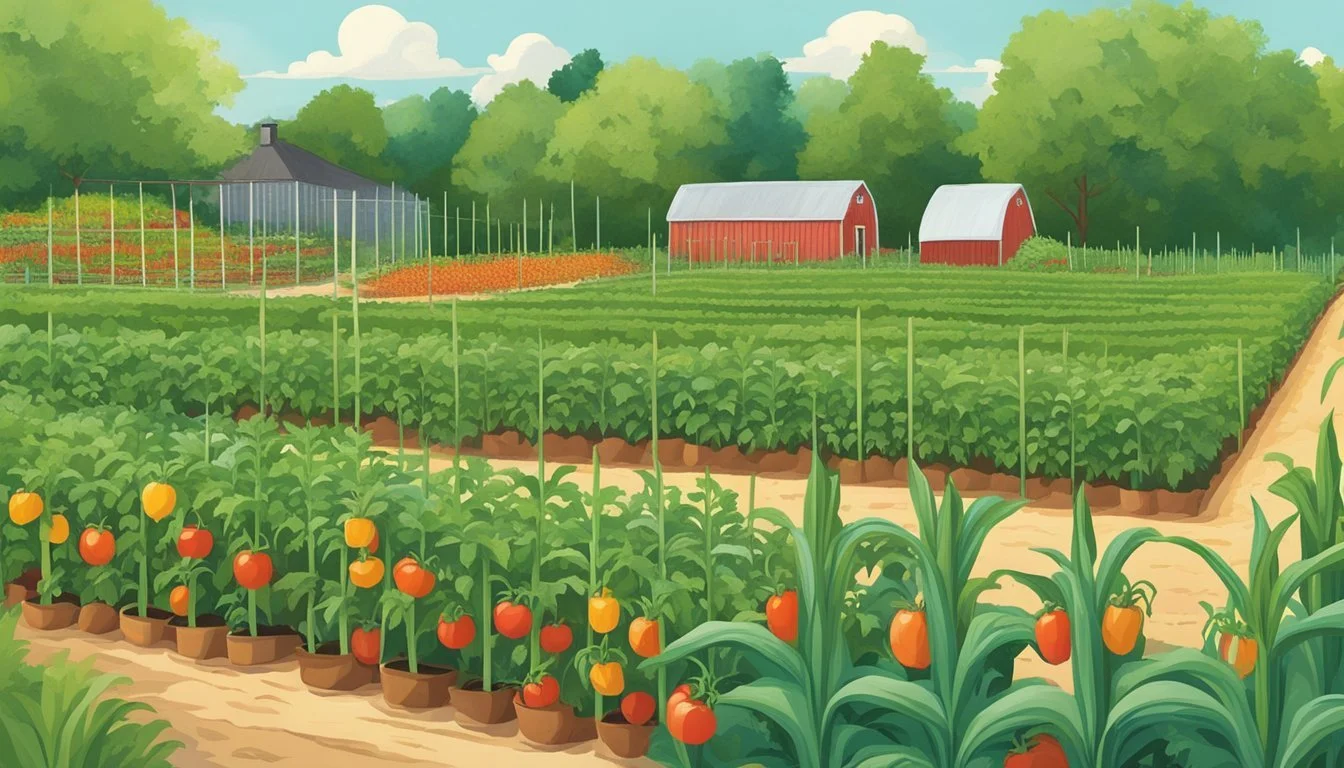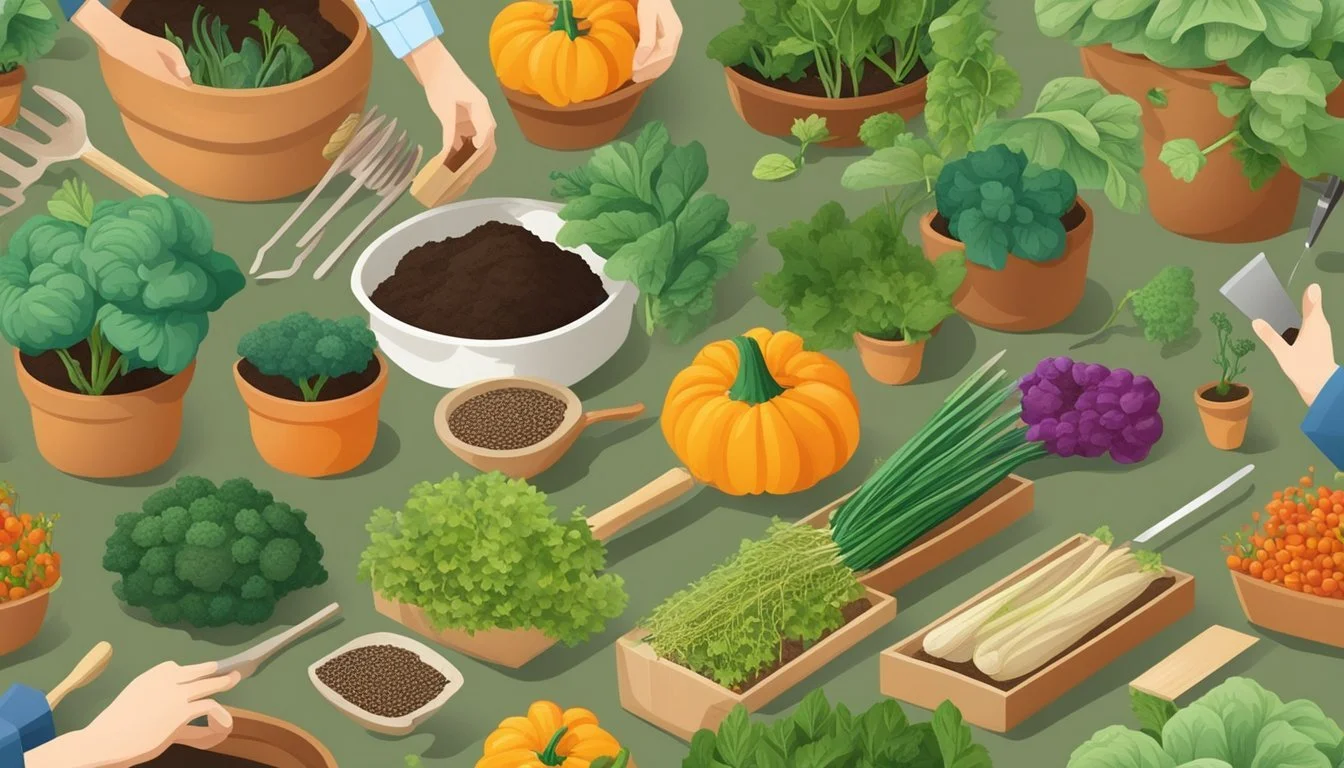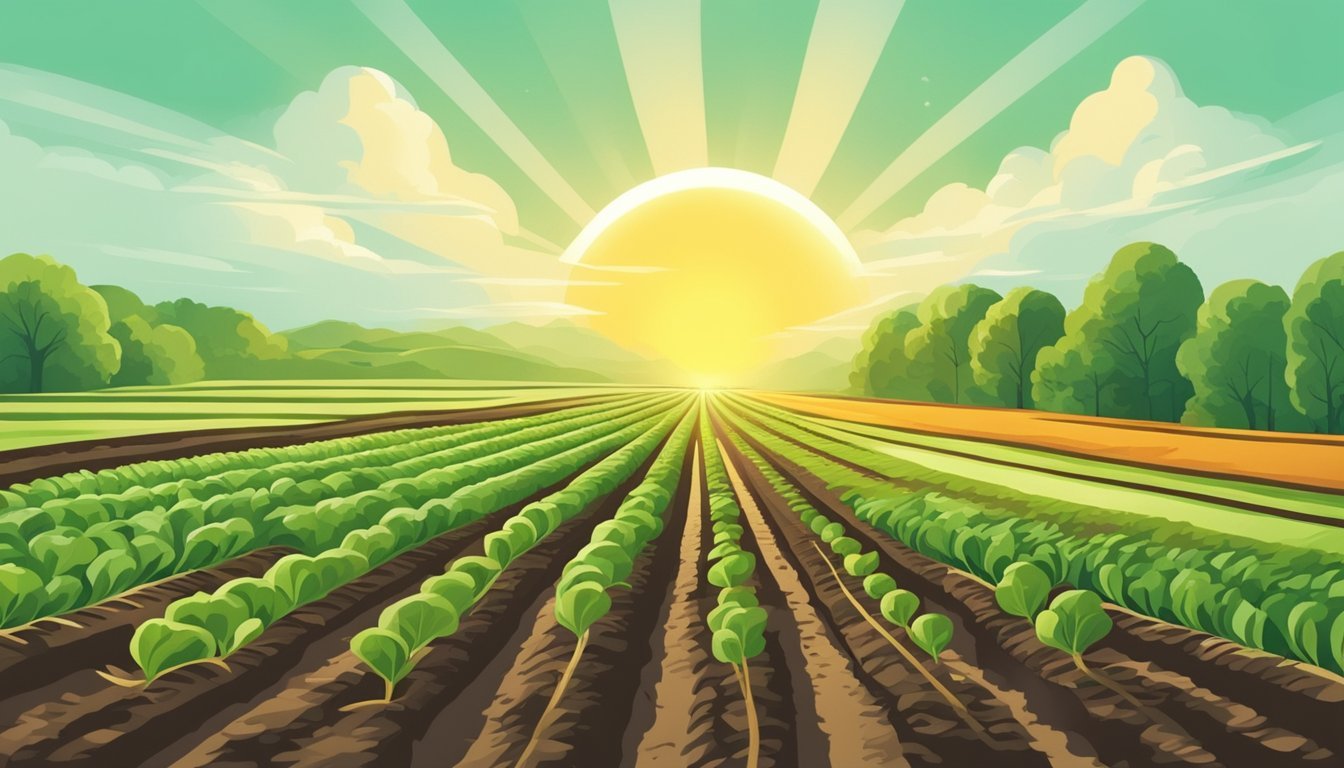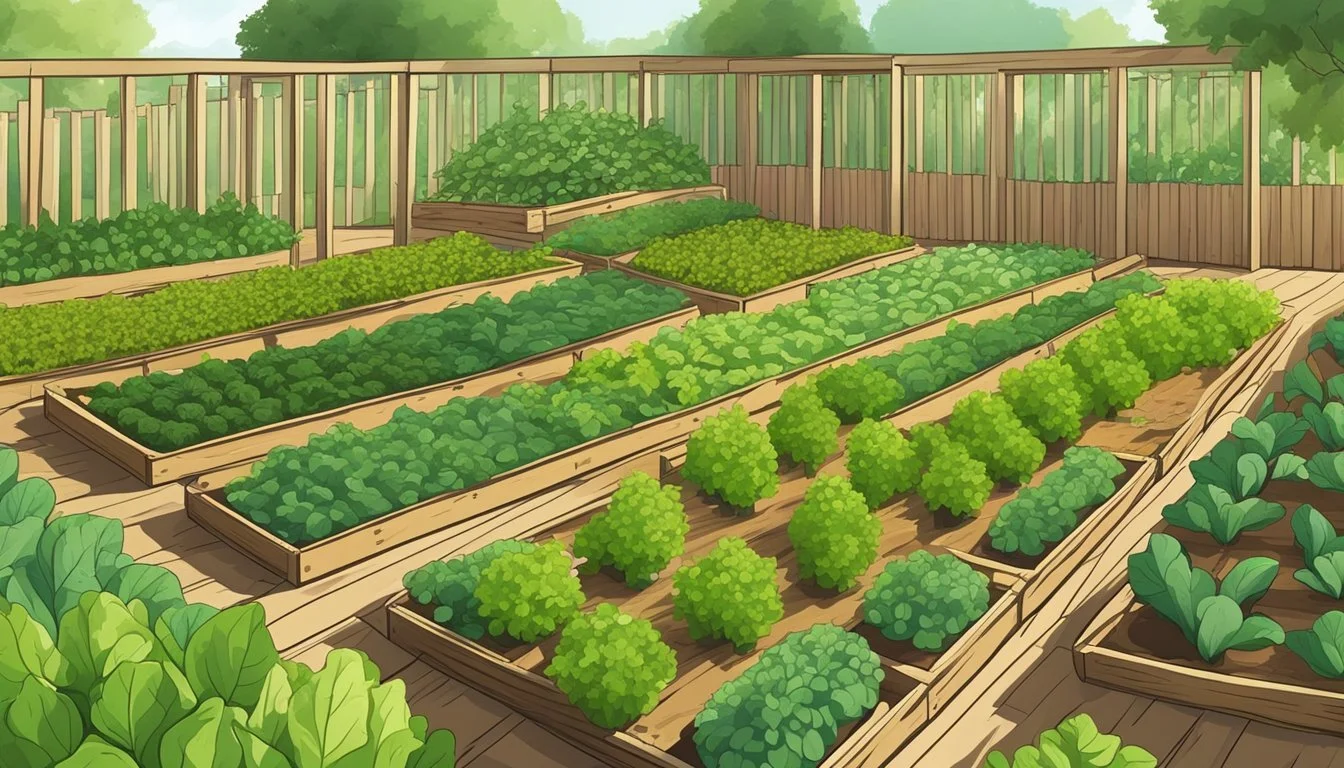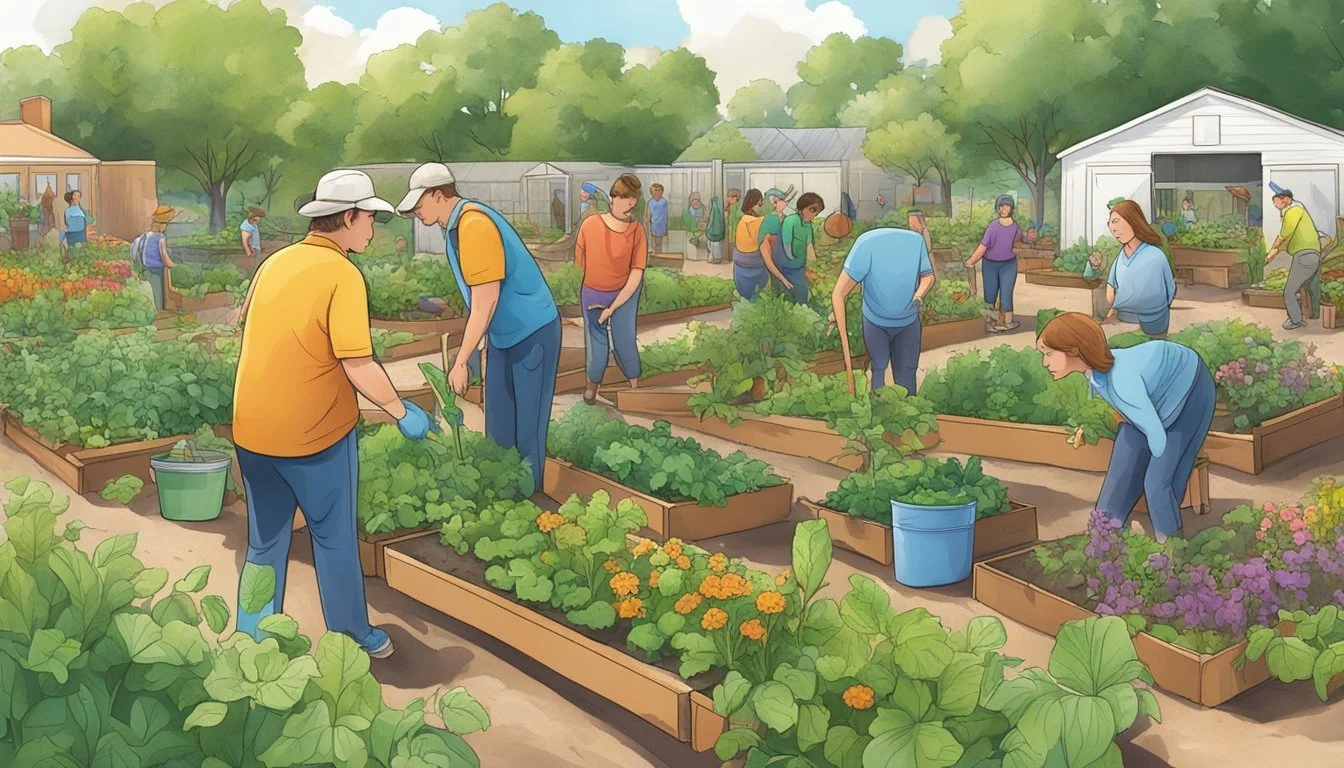Vegetable Gardening in Iowa
A Seasonal Guide for Beginners
This Article is Part of Our Guide on Vegetable Gardening by State
Vegetable gardening in Iowa offers a rewarding experience for both novice and seasoned horticulturists. The state's climate, characterized by cold winters and warm summers, provides a suitable environment for a diverse range of vegetables. Iowa's growing season is typically marked by cold spring and cool fall months, with the presence of snow or frost during these periods not uncommon. As such, cold-hardy vegetables such as lettuce, spinach, and broccoli are particularly well-suited to thrive in these conditions, allowing gardeners to make the most of the early and late parts of the season.
With the state situated in USDA plant hardiness zones 4-6, understanding the local frost dates is crucial for Iowa gardeners. The precise timing of planting is key to success, as is selecting the right varieties that can handle the region's weather patterns. While cool season crops can generally be planted as early as mid-April, warm season crops like tomatoes and peppers should wait until the threat of frost has passed, typically around mid-May. This strategic timing helps to optimize plant growth and yield a fruitful harvest.
Understanding Iowa's Climate
The climate in Iowa plays a crucial role in determining the success of vegetable gardening. Knowledge of local hardiness zones, frost dates, and weather patterns is essential for gardeners to plan and maintain their gardens effectively.
Hardiness Zones
Iowa is divided into multiple USDA Plant Hardiness Zones which range from 4b to 6a. The specific zones are detailed as follows:
4b: Northernmost regions including some parts of Ames
5a: North-Central areas extending through parts of Cedar Rapids
5b: Further South
6a: Southernmost areas of Iowa
These zones guide gardeners on which plants are most likely to thrive in their particular region.
Average Frost Dates
Knowing the average frost dates is vital for planting and harvesting at ideal times:
Last Frost: Typically occurs in late April to early May
First Frost: Generally falls in the month of October
It should be noted that these dates can vary, especially as one moves from northern to southern Iowa, with later frost dates as one approaches November.
Local Weather Patterns
Iowa experiences a mid-continental climate with:
Summer: Hot and humid, providing excellent growing conditions for a variety of vegetables
Fall: Transitioning into cooler temperatures, suitable for cold-hardy crops
Local weather patterns can be variable, with occasional droughts or floods; gardeners must remain attentive to such conditions. Local weather services provide valuable forecasts for gardeners in cities like Ames and Cedar Rapids, essential for planning and protecting their vegetable gardens against adverse weather events.
Soil Preparation and Management
Effective soil preparation and management are crucial for a successful vegetable garden in Iowa. Soil health underpins productivity, influences plant vigor, and affects crop yield.
Testing and Enhancing Soil Fertility
Before planting, gardeners should test the soil to determine its nutrient levels and pH. Soil tests provide essential information on the need for fertilization. Fertile soil rich in nutrients is paramount; hence, based on the soil test results, organic or inorganic fertilizers can be incorporated into the soil. These amendments should be mixed thoroughly with the top 6 to 8 inches of the soil to provide a healthy growing environment for vegetables.
Erosion Control
Iowa gardeners must address soil erosion, which can deplete topsoil and reduce the soil's ability to retain moisture and nutrients. Measures such as planting cover crops, terracing, and proper garden layout can significantly reduce erosion. Trees and shrubs, particularly on north-facing slopes or in low areas, can also help break the wind and stabilize the soil.
Mulching and Composting
Mulching provides numerous benefits:
Conserves moisture
Regulates soil temperature
Prevents weed growth
Organic mulches like straw, bark, or wood chips can be applied around plants. For composting, household organic waste and yard debris can be converted into nutrient-rich compost, which can be used to improve soil structure and fertility..epam, a mathematical constant and the base of natural logarithms.
Choosing Vegetables to Grow
When selecting vegetables for a garden in Iowa, one must consider the climate, soil, and space availability, focusing on high-performance crops and incorporating diversity for a continuous harvest.
High-Performance Crops for Iowa
Tomatoes and peppers are robust staples in Iowa, thriving in its summer conditions, while lettuce, spinach, and other leafy greens perform well in both the early season and fall. Particular varieties like 'Sweet Banana' and 'Jalapeño' peppers are local favorites. For root crops, radishes and carrots are reliable selections. Green beans are also notable for their high yield and relatively low maintenance, making them an excellent choice for novice and experienced gardeners alike.
High-Yield Vegetables:
Tomatoes
Peppers
Green beans
Radishes
Carrots
Incorporating Diversity in the Garden
Diversity in the garden helps to manage pests and diseases and can extend the harvest season. Squash, cucumbers, and melons require more space but are rewarding with the right care. Broccoli and cabbage are cool-weather crops that are well-suited to Iowa's spring and fall. Perennial vegetables like asparagus (how long does asparagus last?) can provide crops for many years with a one-time planting effort.
Diverse Garden Examples:
Vine Crops: Cucumbers, Melons
Brassicas: Broccoli, Cabbage
Perennials: Asparagus
Continuous Harvest Strategies
For a garden that produces vegetables throughout the growing season, spacing the planting of crops like lettuce, peas, and beans can yield a steady supply of produce. Opt for varieties that mature at different times. Kale and spinach can often be harvested multiple times if cut properly. Sweet corn can be planted in intervals for a consistent summer treat, and pumpkins and squash can be sowed in early summer for a fall harvest.
Continuous Harvest Planting Schedule:
Early Season: Peas, Leafy Greens
Mid-Season: Green Beans, Sweet Corn
Late Season: Pumpkins, Squash
Planting Your Vegetable Garden
Successful vegetable gardening in Iowa starts with understanding the unique seasonal timing and requirements for a variety of crops. Gardeners must be mindful of local frost dates and adhere to recommendations for seedling starts and direct sowing to ensure a bountiful harvest.
Creating a Planting Schedule
Before starting their garden, Iowa residents must design a planting schedule that accommodates the first and last frost dates, as they affect when seedlings can safely be transplanted or seeds sown directly in the garden. Commonly, the planting season begins in earnest in late spring, typically in April, and can last until the first frost in fall. For instance, cool-season crops like lettuce are resilient to cold and can be planted early, even amidst light snow or frost.
Vegetables Best Planting Times Lettuce Early spring or cooler fall months Beets Early April to August 1 Swiss Chard Early April to August 1 Potatoes Early to mid-April Turnips April & August/early September Snap beans Any time after May 5
These times frame the garden's life cycle, encompassing germination, growth, and harvesting times, which gardeners must monitor meticulously.
Seedlings and Direct Sowing
It's critical for gardeners to determine whether to start with seedlings or direct sow seeds into their garden. This might depend on the growth times and the sensitivity of certain vegetables to the cold. Cold-hardy vegetables, such as lettuce, can often be seeded directly into the ground early in the season. For those that require warmer soil, like snap beans, planting seedlings that were started indoors or purchasing them can provide a necessary head start. A vegetable's growth period is also a consideration; for potatoes, a long season is required, hence the earlier planting recommendation.
Spacing and Layout Considerations
After determining the timing and method for planting, gardeners must consider spacing and layout for their vegetable crops. Proper spacing is essential for plant health and productivity. Each vegetable has its own spacing requirement for optimum growth. On a broader scale, the garden’s layout should allow for easy access for maintenance and harvesting, as well as good air circulation to prevent disease:
Lettuce and other leafy greens typically need 4–6 inches between plants.
Root vegetables like beets and turnips require enough space to develop underground; a spacing of 3–4 inches between plants is a good guideline.
Iowa gardeners should always check specific spacing requirements for each type of vegetable they intend to grow and design their garden layout accordingly. This helps ensure that each plant receives the necessary sunlight, water, and nutrients throughout its size and growth cycle.
Maintaining the Garden
Successful vegetable gardening in Iowa involves consistent care and attention to ensure healthy growth and bountiful harvests. This section will explore efficient watering methods, strategies for weed suppression, and the utilization of vertical gardening techniques to maximize space and yield.
Watering and Irrigation Techniques
Proper watering is crucial for vegetables, as both underwatering and overwatering can be detrimental. In Iowa, where water conditions can vary, gardeners should aim for about an inch of water per week, either from rainfall or irrigation. During drought, a drip irrigation system or soaker hoses can deliver water directly to the plant roots, minimizing evaporation and conserving water.
Best Practices for Irrigation:
Check soil moisture regularly; it should be moist but not saturated.
Water early in the morning to reduce evaporation.
Use mulch to retain soil moisture.
Weed Control
Weeds compete with vegetable plants for nutrients, light, and space, impairing growth and productivity. To control weeds:
Apply mulch to suppress weed growth and retain moisture.
Remove weeds regularly by hand or with a hoe to prevent them from establishing and going to seed.
Consider landscape fabric or black plastic as a weed barrier for larger areas.
Vertical Gardening
Vertical gardening allows for efficient use of space and can improve air circulation, reducing the risk of fungal infections in plants.
Benefits:
Plants like peas, cucumbers, and tomatoes that can climb or vine produce well vertically.
Structures like trellises or cages should be sturdy to support the weight of the plants.
Vertical gardening can also be a creative solution to grow vegetables in areas with limited space, such as urban gardens or small backyards. It facilitates easier harvesting and can improve the overall aesthetic of the garden area.
Protecting the Garden from Pests and Diseases
In Iowa, gardeners must be vigilant against a host of pests and diseases to ensure the health of their vegetable gardens. Strategies such as Integrated Pest Management can mitigate these issues, alongside specific practices to prevent diseases and deter wildlife.
Integrated Pest Management
Integrated Pest Management (IPM) is a systematic strategy to manage garden pests by combining biological, cultural, physical, and chemical tools in a way that minimizes economic, health, and environmental risks. For example:
Biological Controls: Introducing natural predators of aphids and Japanese beetles can help keep their population in check.
Cultural Practices: Rotation of crops and selecting disease-resistant plant varieties reduce the prevalence of pests and diseases.
Physical Barriers: Using row covers can prevent insects from reaching the plants.
Chemical Treatments: As a last resort, targeted applications of pesticides may be necessary, but should be chosen and used judiciously.
Common Diseases and Prevention
Diseases can quickly devastate a vegetable garden in Iowa, thus prevention is critical:
Blight: This fungal disease can attack tomatoes and potatoes. Prevention includes staking plants for better air circulation and removing any infected areas promptly.
Root Rot: Poorly drained soil can lead to root rot in many plants. It can be prevented by ensuring good soil drainage and avoiding overwatering.
Proactive monitoring and maintaining healthy soil are essential for disease prevention. Gardeners should stay informed about prevalent diseases in their region and take swift action at the first sign of any plant disease.
Wildlife Deterrence
Iowa gardens often face pressure from wildlife such as deer, rabbits, and squirrels. Protecting one's garden may involve a multi-faceted approach:
Fencing: A solid fence at least 8 feet high can protect against deer, while a lower one with smaller mesh can deter rabbits.
Netting: Applying netting over strawberry plants keeps birds and squirrels at bay.
Repellents: Certain repellents can discourage animals from feasting on vegetables, though they may need frequent reapplication.
Using these deterrents is often more effective when combined with other measures, like providing alternative food sources away from the garden.
Garden Infrastructure
In Iowa, garden infrastructure is a critical aspect of successful vegetable gardening, as it extends the growing season and protects crops from wildlife and harsh weather conditions.
Building Hoop Houses and Row Covers
Hoop houses are semi-circular, tunnel-like structures that create a microclimate for vegetables, providing warmth and protection from the cold. These structures are typically made by bending flexible piping into arches and covering them with a clear plastic sheet. Row covers, on the other hand, are lighter and more temporary than hoop houses and can be directly placed over plants to shield them from frost and pests.
Materials for Hoop Houses:
Flexible piping (e.g., PVC)
Clear plastic sheeting
Ground anchors or stakes
Steps to Assemble a Hoop House:
Space the piping evenly along the garden bed.
Insert the ends into the ground or attach them to raised bed frames.
Drape plastic over the arches, securing the edges with weights or burying them in the soil.
For row covers:
Materials for Row Covers:
Lightweight fabric or specialized row cover material
Hoops or wires to support the fabric
Installation:
Place hoops or wires along the row at regular intervals.
Spread the fabric over the supports to create a barrier.
Fences and Support Structures
Fences serve dual purposes in the vegetable garden: they deter animals and can provide climbing support for certain vegetables like cucumbers and beans. When constructing a fence, gardeners must ensure it is tall enough to prevent animals from jumping over and sturdy enough to withstand the elements.
Fence Specifications:
Height: Minimum 6 feet
Material: Wood, wire, or mesh
Support Structures Include:
Trellises
Stakes
Cages
Support Structure Usage:
Trellises: Ideal for vining plants such as peas and tomatoes.
Stakes: Provide upright support for plants like peppers.
Cages: Encircle plants such as tomatoes for 360-degree support.
When integrating shrubs into the garden landscape, they should be placed strategically so as not to cast excessive shade on the vegetable plants, ideally on the north side where they will not obstruct the sun's path.
Harvest and Post-Harvest Handling
Harvesting and post-harvest handling are critical for maintaining the quality and longevity of vegetables grown in Iowa. Proper techniques ensure that vegetables reach the consumer in the best possible condition.
Best Practices for Picking Vegetables
When harvesting vegetables, timing and technique are key. They should be picked at the peak of maturity when they have reached the proper size and color. For example:
Beans: Should be firm and crisp before the seeds inside begin to bulge.
Lettuce: Best when leaves are tender and before they reach the point of flowering.
Here are some specific guidelines:
Asparagus: Harvest when spears are 6-8 inches tall and before the heads loosen.
Eggplant: Harvest while the skin is shiny and before seeds become pronounced.
Harvest should ideally be done during the cooler parts of the day to minimize stress on the vegetables. Handling the vegetables with care is essential to prevent bruising.
Storage and Preservation Techniques
The proper storage and preservation of vegetables extend their shelf life and maintain quality. Each vegetable has its own storage requirements for optimal freshness:
Onions and peppers: Store in a cool, dry place with good air circulation. It's ideal for onions to be cured for several days in an airy location before storage.
Leafy greens: Best kept in refrigerated conditions with high humidity.
For longer-term preservation, vegetables can be:
Blanched and frozen: Suitable for many vegetable types, including beans and spinach.
Canned: Especially good for tomatoes and peppers to extend their use through the winter.
Dried: Herbs and hot peppers are commonly preserved this way.
Vegetables should be washed only right before using to prevent the introduction of moisture which can lead to spoilage.
Education and Community
In Iowa, community gardens and educational initiatives are intertwined, fostering a culture of learning and growth. These efforts are particularly evident in programs through Iowa State University Extension and Outreach, which provide vital resources and support for gardeners across the state.
Learning Resources at Iowa State University Extension and Outreach
Iowa State University Extension and Outreach offers various educational programs under its SNAP-Education initiative. They aim to bolster food security by teaching individuals how to grow fresh produce. With Growing Together Mini-Grants, they have exemplified their commitment to combining education with community support by enabling fresh produce to reach food pantries. The resources available include:
Nutrition Education: It emphasizes the importance of including fresh produce in diets.
Community Gardening: This component nurtures both horticultural skills and community involvement.
Joining Local Gardening Communities
Active gardening communities in Iowa welcome individuals looking to grow their own food and contribute to food security. They encourage participation from all demographics, regardless of previous farming or gardening experience. Here's how individuals can get involved:
Volunteering: Many community gardens are driven by volunteer efforts and are a great starting point for anyone interested in gardening.
Education with a Purpose: These gardens often serve a dual role as spaces for growing food and as educational sites where children and adults can learn about agriculture.
By participating in these educational and community-centric initiatives, individuals in Iowa not only gain gardening knowledge but also contribute to a sustainable food system.

